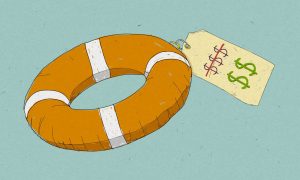Buying life insurance may be less costly than you think, particularly if you follow some fairly simple steps to keep your premiums down. Research from LIMRA, a membership organization for life insurers, shows that despite record-high consumer intent to purchase coverage, “too many Americans mistakenly feel life insurance is financially out of reach or too difficult to obtain.”
If you’re looking for a policy that won’t break the bank, while still covering your loved one’s expenses after you die, a number of moves can allow you to score the lowest rate you can.
Buy a term policy
Permanent life insurance, such as whole life coverage, provides lifelong coverage, along with a savings component of a policy known as its cash value. But you’ll pay a price for those advantages. A permanent policy can easily cost three to five times as much as buying the same amount of term life insurance, says Barb Pietrangelo, a financial planner and insurance expert at Prudential. On average, term life policies cost only about $165 per year, LIMRA reports.
As the name implies, term life insurance covers you for a defined period, typically between 10 and 30 years. Select a term length that will cover the years your family will most need protection. That might be the time until your children reach adulthood or your mortgage will be paid off.
While you should be careful not to choose a term that’s too short, there’s a financial incentive to not buy longer coverage than you really need. The longer the policy term, as a rule, the higher the annual premium.
Get insured when you’re still young
The main reason to buy life insurance earlier in life is that, as a rule, the younger and healthier you are, the lower your premium. Taking out a policy in your 20s or 30s — when you’re less likely to suffer health conditions like diabetes, high cholesterol or high blood pressure — allows you to lock in the most affordable coverage for the coming decades.
“When you buy life insurance young, your premiums remain the same for the duration of your policy unless you change the coverage amount. This will reduce the total amount you’ll spend on life insurance throughout your lifetime,” explains LIMRA CEO David Levenson.
However, the sooner a term policy begins, of course, the sooner it ends — potentially leaving you uninsured at an age where you still require coverage. If you still need insurance when the policy term expires, most life insurers offer the option to convert your term life policy to a permanent one, says John Buenger, senior financial manager and advisor at the Rice Agency.
Such a conversion, though, will subject you to the sticker shock of a permanent policy. Another alternative for continuing coverage is to take out another term life policy. While the premium will be lower than for converting the old policy to a permanent one, you’ll still pay more than for the original policy, because you’ll be older than you were when you got that coverage.
However, you may not need the same death benefit as you did decades ago, because your kids are out on their own or you’ve retired the mortgage. So you could offset at least some of the impact of your age on the policy’s cost by buying a lower amount of coverage than you originally had.
Quit smoking
The health risks associated with tobacco use mean insurers set higher premiums for smokers than nonsmokers. According to the Centers for Disease Control and Prevention, cigarette smoking is linked to about 80% to 90% of lung cancer deaths in the U.S.
“Quitting smoking can save you a lot of money in the long run,” says David Adler, president of Adler Insurance Group. “If you already have a life insurance policy and have quit smoking, request a re-qualification for nonsmoker rates after you’ve been tobacco-free for at least 12 months.”
Live healthily
Several life insurers offer policy discounts if you exercise or otherwise take good care of yourself, and are prepared to share details about your activity via an app and a wearable monitor such as a Fitbit.
John Hancock’s VitalityPLUS plan is structured much like an airline frequent flyer plan, with premium discounts of up to 25% depending on how many points you accumulate through exercise or by eating well. You’re also entitled to discounts at thousands of grocery stores on a list of approved food types. Health IQ promises comparable healthy living discounts on its policies, and Sproutt says it will be launching a similar offering in the months to come.
Make premium payments annually
How you pay your premiums can help you save money on life insurance, says Ben Reynolds, CEO of Sure Dividend. Paying for your policy once a year, rather than every month, is a less expensive option, he says.
Not everyone can afford to make annual premium payments, but those who can could save up to 5% in premiums, depending on the carrier.
Buy only the coverage your family will need
Purchasing a life insurance policy involves choosing a death benefit amount that will allow your beneficiaries to be financially solvent were you to die. As with determining the right policy term, it’s prudent to buy no more coverage than your family will really require.
The Insurance Information Institute suggests you first take into account other sources of income your family might have access to after your death, such as Social Security and retirement benefits or an employer-sponsored life insurance policy.
Next, add up the expenses your survivors would incur if you died. These could include burial expenses, replacing hidden income — such as work benefits that aren’t part of your wages — or the replacement costs for any services you provide for the family, like tax preparation.
Once you have totaled those numbers, subtract your family’s total income and other assets from that sum. This should give you a relatively accurate picture of how much coverage your family will actually need to be made whole in your absence. This methodology is more precise — and may result in lesser coverage and lower premiums — than some other methods of calculating life insurance needs, such as buying a multiple of your annual income.
Shop around
Finally, as with other forms of insurance, the surest way to find the right life insurance at the right price is to compare what different insurers are offering.
This is something you can do on your own if you already know what you need. Still, you may want to consider working with an independent agent or an online broker such as Policygenius. Such intermediaries can shop for policies from different life insurance companies so you can get the lowest premium, says Adler.
Daily Money
Every day we publish the latest news, stories, and content on the financial topics that matter. This is your daily guide to all things personal finance.
The post 7 Ways to Pay Less for Life Insurance appeared first on Bankrate
Original source: Bankrate






